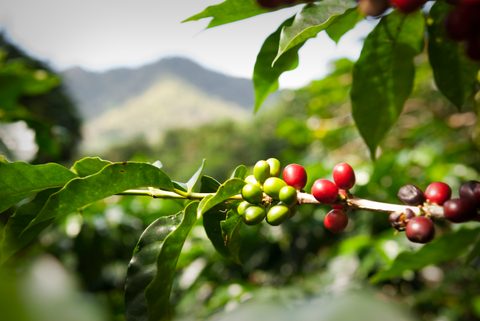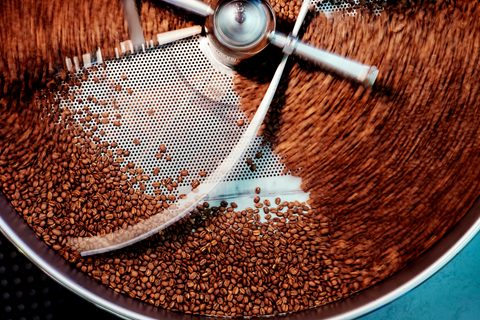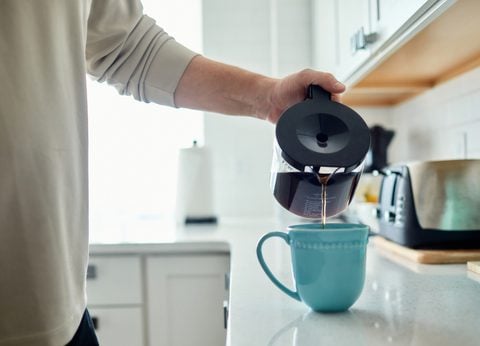Dangerous information, espresso drinkers: In response to the most recent inflation report, the typical retail value of roasted espresso has risen 14.8% since final July.
Worse information: A few of President Donald Trump’s highest new tariffs began this month and are throwing the espresso provide chain into disarray. They seem destined to ship costs of America’s go-to beverage even greater within the months forward.
Excessive-quality espresso beans are grown in a couple of key nations, just about all of that are topic to new tariffs. Brazil is by far the largest, supplying 37% of world manufacturing final 12 months, and it was hit with a blanket 50% tariff that took full impact Aug. 6.
Bean costs are leaping
Brazil’s high-quality arabica beans type the bottom of many widespread specialty blends. Business sources we spoke to say {that a} 50% value hike is probably going an excessive amount of for roasters and shoppers to swallow, with importers and roasters alike questioning find out how to reply.
“I can tell you from conversations with some customers, there’s not an appetite to purchase large volumes of Brazilian coffee with a new 50% tariff,” says Peter Radosevich, a dealer and worldwide gross sales crew chief for specialty importers Royal Espresso, primarily based in Oakland, Calif.
“One of Brazil’s greatest selling points, because it’s one of the largest producers, has been its price point. And so when you remove that from the equation, I think people will move away from using it for sure.”
Which raises the query of find out how to discover a alternative in a finite market the place just about each viable bean grown already finds its manner right into a cup someplace on the planet.
“Right now, roasters in the U.S. are scrambling to figure out, with the Brazil tariffs, what they’re going to replace it with,” says Spencer Turer, vice chairman of Espresso Enterprises, a Vermont-based firm that gives consulting and product testing to the espresso commerce.
“Or, they’re just going to have to absorb the costs and either reduce their profitability or pass those prices on to the consumer.”
Tariffs starting from 10% to 50% are actually in place on imports from nearly each coffee-producing nation.
The lone exception is Mexico, the place espresso is roofed by the pre-existing U.S.-Mexico-Canada Settlement (USMCA). However in accordance with each Radosevich and Turer, costs are rising there even with out tariffs — pushed by excessive demand as consumers crowd in to purchase up out there beans.
Earlier than these beans can grow to be a cup of joe — whether or not you make your espresso at residence or decide up a cup from a restaurant — they must be roasted. So the place does the present market turmoil depart roasters, of which there are hundreds within the U.S., giant and small?
“Intellectually, I would look at where the harvest cycles are, where coffee is fresh, what’s going to taste similar,” says Turer. “But once you make that conclusion, you have to realize that there are hundreds of roasters that have probably reached that conclusion before you, and already made those phone calls to the importers.”
Why tariffs on espresso?
Truthful query. A conventional rationale for tariffs, and one which Trump cites, is to defend a home business. However espresso, as an agricultural product, will not be climactically suited to the contiguous United States. It’s produced on solely a miniscule scale (by international requirements) in Hawaii and Puerto Rico, with some fledgling efforts in California.
Espresso is, basically, collateral harm in Trump’s push to reshape international commerce.
Till the day Brazil’s tariffs went into impact, there have been hopes that espresso would get an exemption, and the co-chairs of the bipartisan Congressional Espresso Caucus (sure, there’s a Congressional Espresso Caucus) despatched a letter to the administration in late July urging that unroasted espresso be exempted from all tariffs.
“Unlike many other goods affected by recent tariffs, coffee is not produced at a scale within the United States that can meet domestic demand,” acknowledged the letter, signed by U.S. Reps. Jill Tokuda, D-HI, and William Timmons, R-S.C., co-chairs of the caucus.
“Every $1 of imported coffee creates an estimated $43 in value throughout the supply chain, and coffee shops, roasters, and distributors serve as important economic engines supporting small businesses and creating jobs that help sustain local economies.”
Hopes for a espresso exemption haven’t panned out, successfully conserving the business in paralysis. An exemption might nonetheless are available in an setting the place recent tariffs bulletins are made nearly every day, however roasters not have the posh of ready.
The espresso provide chain: a thumbnail sketch
It’s an extended street from a espresso farm to your cup.
Espresso producers around the globe can vary from giant plantations to small family-run operations, in addition to cooperative farms. After harvest, the inexperienced beans — the seed of a espresso tree “cherry” — will be dried and processed (by considered one of a number of strategies) on the farm or at a shared facility earlier than being bagged for export.
Like different commodities, the baseline value of espresso is about by a futures market that’s largely populated by merchants who could by no means take possession of a bag of beans.

Components within the futures value of espresso can vary from on-the-ground circumstances, like climate patterns and crop yields, to technical elements, like the value of oil, rates of interest and the energy of the U.S. greenback.
Again-to-back droughts in Brazil have brought about costs to spike lately, for instance.
“Coffee has always been stated as one of the most volatile commodity prices in, basically, the world,” Turer says. “And it moves pretty aggressively day to day, month to month, week to week, and it goes up, it goes down, it changes, sometimes it goes beyond logic.”
And since there may be such a spectrum within the high quality of unroasted beans, most are purchased and offered at a differential to the commodity value. Decrease-quality beans promote for much less whereas fascinating varietals promote for extra — typically way more.
Probably the most sought-after beans within the specialty market are usually grown at greater elevation, in locations akin to Colombia and Ethiopia. These beans will be roasted and marketed as single-origin coffees or utilized in blends.
Enter the importers, greater than 7,000 of whom function in the US, who usually construct shut relationships with producers giant and small everywhere in the world.
Radosevich’s firm, Royal Espresso, imports from greater than 30 nations, starting from Indonesia to South America.

“It’s a weekly exercise in trying to figure out how to maintain both a good supply of coffee for our customers at a good price and also maintain relationships with suppliers,” Radosevich says.
“I mean, we want to honor every contract we’ve written, so we’re going to do that. But going forward, it is hard to make the same commitments that we’ve made. You know, for purchasing this year without knowing where these tariff levels may be.”
Importers are tasked with getting the beans, sometimes packaged in 60-kilogram sacks, to market within the U.S. That’s when normal disruptions in international delivery additional complicate the image.
“Not just coffee, but all transporters, all freight companies, are kind of reshuffling where they’re sending ships. That’s just kind of in constant flux,” says David Yake, director of gross sales and sustainability for Tony’s Espresso, a roaster primarily based in Bellingham, Wash. “It feels COVID-reminiscent. It’s not as bad as COVID, but it’s definitely returning to a higher level of unpredictability.”
As soon as they’re in a position to safe their provide, importers promote to roasters in the US (and elsewhere), typically on advance contracts and typically on a spot foundation. Estimates range, however there are at the least a number of thousand unbiased roasters within the U.S.
Among the gamers, like Starbucks and Keurig, are mammoth and have scale on their aspect, whereas smaller roasters are scrambling to safe their provides at a value they will afford. Tariffs are tacked onto the value roasters pay, even when they’ve a pre-tariff contract, and a few or all of that can be handed on to the espresso drinker.
“The tariffs are being paid by U.S. small businesses,” says Yake. “This notion that they are being paid by the producing country is not true. We see the tariffs on our invoices that we pay every month.”

Tony’s will not be depending on Brazilian espresso, however the firm had already been grappling with the final 10% baseline tariffs which were in place for months, in addition to general escalation in espresso costs over the previous two years.
“Drought, climate change, have had a real impact on coffee supply and stocks globally. These were all pre-tariff concerns,” Yakes says. “Our sales have definitely suffered. We do a lot of our distribution through grocery channels, and I think consumers are already shopping sales. We have very loyal customers but I think brand loyalty only goes so far when you’re seeing double-digit price increases.”
Chuck Nigash runs a boutique specialty roaster known as Elevated Roast in Bainbridge Island, Wash., that sells on to a core of regular prospects. He’s making an attempt to maintain his lineup of choices — and his costs — as secure as doable whereas adjusting to the altering espresso panorama.
“I figured out that my own tariff costs are roughly 21%,” he says.
“I’m intentionally eating half of that, because I don’t want the customer to eat that,” he provides — however he runs such a small operation that he’s ready to try this whereas nonetheless making a margin he can dwell with. Not all roasters, particularly these with debt or tighter margins, have as a lot flexibility.
“So, when a supply chain as complicated as coffee starts to get disrupted on political issues, on U.S. currency issues, on tariff issues,” it may be destabilizing for roasters, Turer says. “This causes all kinds of consternation, all kinds of financial stress, and with the interest [rates] pricing up, there are companies that may potentially close, because they don’t have the availability for credit, and they don’t have the profitability to stay functioning with their cost of goods going up.”
The place will Brazil’s espresso go?
If U.S. importers purchase considerably much less Brazilian espresso whereas tariffs are in place, which appears possible, different coffee-consuming nations will undoubtedly step up.
As an illustration, whereas the US is the only greatest espresso client on the planet, the European Union collectively drinks extra espresso — and already imports a couple of third of it from Brazil.
After which there’s China. The identical week that the U.S. tariffs on Brazil had been made official, China licensed 183 Brazilian espresso firms to export into the nation.
Espresso consumption is on the rise in China, however the transfer is basically seen as a soft-power play to construct political capital with the largest South American economic system whereas its buying and selling and political relationship with the US founders.
“There’s a saying we have in the coffee industry,” Turer says. “All coffee will find a home.”
And what is going to espresso drinkers do?
An April 2025 survey by the Nationwide Espresso Affiliation discovered that 66% of American adults drink espresso every single day, surpassing the consumption of tea, juice, soda and bottled water. The recognition of dearer specialty coffees has risen 18% for the reason that similar survey was final carried out in 2020.
The best way People devour their espresso varies in fact, from a macchiato at Starbucks to a pot of residence brew courtesy of Mr. Espresso. The survey discovered that 71% of past-day drinkers made at the least one cup at residence, 16% had espresso ready out of residence solely, and 13% had espresso ready each out and in of residence.
Those that make espresso at residence overwhelmingly purchased their provides at grocery shops, big-box shops and membership shops.
As costs rise, shoppers should determine whether or not to soak up the extra value or make a money-saving adjustment — ingesting much less espresso, switching to cheaper manufacturers, ingesting espresso away from residence much less usually, or some mixture of the above.
“People can change their consumption, right? If they want to make sure they get their cup of coffee in the morning, there’s different ways to get that cup of coffee,” says Turer.
Espresso being espresso, although, a change in habits will not be all the time simple.
“It’s a ritualistic product,” says Turer, “which means the consumer expects the coffee to look, smell and taste the same way every time.”
#Tariffs #Buzzkill #Espresso #Biz

Leave a Reply